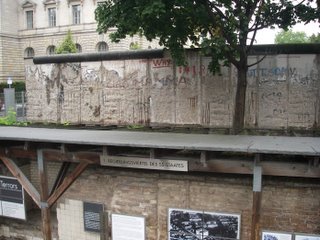
From Checkpoint Charlie, I walked a distance to a point on the map where there's a section of wall left standing. (near Potsdamer Platz, if memory serves). And this is it. That's all it was, (the wall itself). About three and a half inches thick, reinforced concrete. It rose, in sections, to about nine feet high where it was capped by a cylinder of concrete that fit over the ends, linking them together.
This "all it was" was augmented by guard towers, dog patrols, searchlights, barbed wire, fences, barriers, mines, booby traps, and a rapid reaction force - 24 hours a day. There was a hundred foot section inside the wall, (between an inner ring of fences and barbed wire - and the wall itself) known as the "death strip". Here was a free-fire zone with an easy line of sight for GDR guards to shoot their own people.
 Behind this section of wall, as it turns out, was the former Gestapo headquarters. This is probably the reason this section was preserved - the confluence of both the 20th century's totalitarian nightmares. A developer and city planners want to build a museum here called "The Topography of Terror." But its tied up in a land and funding dispute. Nevertheless, as with the Checkpoint, vistors can gaze at many placards and weather-proof billboards out in the open, listen to push-button recordings of Class-A war criminals answering charges at Nuremburg, (with translation into English), and the like. most haunting were the photographs and entry records (the Gestapo were exceptional record-keepers) of ordinary Germans and Jews who disappeared here. Photo graphs that hung in front of you and were suspended on wires above, blown up to about a 6 by 4 foot portrait. Mug-shots for such crimes as "attending a labor meeting", and "associating with known Jewish subversive agents," and such. You can imagine the rest. What staggers is that the Gestapo felt the need to lie, in their own internal records.
Behind this section of wall, as it turns out, was the former Gestapo headquarters. This is probably the reason this section was preserved - the confluence of both the 20th century's totalitarian nightmares. A developer and city planners want to build a museum here called "The Topography of Terror." But its tied up in a land and funding dispute. Nevertheless, as with the Checkpoint, vistors can gaze at many placards and weather-proof billboards out in the open, listen to push-button recordings of Class-A war criminals answering charges at Nuremburg, (with translation into English), and the like. most haunting were the photographs and entry records (the Gestapo were exceptional record-keepers) of ordinary Germans and Jews who disappeared here. Photo graphs that hung in front of you and were suspended on wires above, blown up to about a 6 by 4 foot portrait. Mug-shots for such crimes as "attending a labor meeting", and "associating with known Jewish subversive agents," and such. You can imagine the rest. What staggers is that the Gestapo felt the need to lie, in their own internal records. 
And here, on a neighboring building, was this relief. Time-honored German craftsmanship. Clockmaking. Perhaps a father and child. Or Guildsman and apprentice. It brought back to me my first impression of Baghdad - peaceful, serene. There's no evil in the land. No crazy in the water. It criss-crosses every human heart - as Solzhenitzen said. Like the Berlin wall, only mobile. Retreating and advancing across the heart's topography. Unless that's what they meant, there's no "topography" to terror.

And here's the backside, facing Potsdamer Platz. The heart of Berlin nightlife - the most renowned in Europe in the 20's and 30's. It was also a large, open-air plaza. The nerve center of the Third Reich was built all around it, which guaranteed its destruction, and the Cold War divided it into.
It has since undergone a renewal, restoring it to a new shine, (and height! The buildings around it look almost like Manhattan)

No comments:
Post a Comment